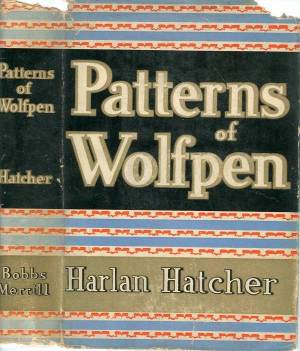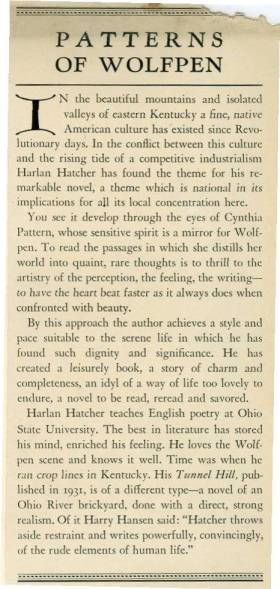|
Romance
and tragedy fill the pages of this
novel about Eastern Kentucky
The story takes place at Wolfpen Hollow
near Gannon Creek in the Big Sandy Valley of Eastern Kentucky. From
numerous references to places in the book, it is apparent that Gannon
Creek is Johns Creek in Pike County. There is a Lower Wolfpen Hollow
near the mouth of Sycamore Creek on the original
Leslie Settlement.
I have always assumed that the land
settled by William Robert Leslie and his son Robert about 1790
extended down both sides of Johns Creek from about the mouth of Caney
Creek to the mouth of Sycamore Creek. It is quite possible it also
extended up Sycamore and farther down Johns Creek. The book tells of
the patriarch of a family having a Virginia patent for 4,000 acres of
land and had expanded his holding to well over 5,000 acres. [2]
May Farm Branch, a small stream that
flows into Johns Creek near the upper end of the Leslie Settlement,
is named for Thomas Patton May who married Elizabeth Margery Leslie
in 1841 and lived on over 1,000 acres of land that they purchased
from her father, Allen Lesley in 1847. [3] She was a grandaunt of the
author and she and Thomas were living on their farm during the years
depicted in the book.
A number of stories of Saul and Barton
are taken directly from family traditions of the Leslie family,
including one that tells of Barton having his throat cut by Indians
and left for dead. (Leslie traditions tell of William Robert Leslie
being the one who had his throat cut by Indians.)
About 1880, as the story began, Cynthia
(i.e. Malinda Leslie) watches her father convert the old
water-wheeled mill her grandfather had built to steam-power. [4] She
speaks of people coming from nearby farms to witness the event. A
farmer from the mouth of Brushy (a creek that flows into Johns Creek
below Sycamore) was among them. Cynthia tells of her father having
the steam engine transported from Cincinnati by steamboat up the Ohio
River to Catlettsburg, where it was transferred to the Cando for its
journey up the Big Sandy. [5] Her father hauled it behind two yoke of
oxen up the Gannon (i.e. Johns Creek) from the river. She related
that this was the same route Saul (i.e. William Robert Leslie) had
taken when he moved his family to Wolfpen Hollow decades earlier.
Cynthia spoke of Saul, a huge man, being
buried on Cranesnest Shelf in a popular log hollowed out by his son
Barton. The same story has been told for generations about William
Robert Leslie and his son Robert and his grave is marked above the
golf course now located on the property. [6]
Eight-five years had passed since Saul
and Barton first settled in the valley and other families had
followed. As the older generations died and their land was divided
among their descendants, people along the creek began to speak of
themselves as living in family 'Settlements.' [7] In the book Cynthia
(i.e. Malinda Leslie), the youngest child in her family, had a number
of siblings. A few are characters in the story. Lucy, the oldest, was
married and lived on the Sandy Farm at Patterns Landing on the river.
Jenny lived on the Horsepen Branch Farm (probably Cowpen near the
river in Pike County). Her mother was from Scioto on the Ohio River
and her father had expanded his home and put weatherboarding over the
logs for his bride. "There was no better house in the Big Sandy
Valley, outside of Pikeville or Prestonsburg." The house had
been built by her grandfather with timber from the farm. Glass
windows and wrought-iron nails were hauled over the mountains by mule
from Mt. Sterling in Central Kentucky. The kitchen then occupied the
room that was once was Saul's original log cabin.
Notes:
[1] Patterns of Wolfpen,
Harlan H. Hatcher, The Bobbs-Merrill Co., Indianapolis & New
York, 1934.
[2] In 1792 the state of
Kentucky was formed from the westernmost region of Virginia and the
Big Sandy Valley was part of Mason County. In 1800 Floyd County was
formed and if the Leslie patent was filed in the courthouse in
Prestonsburg, it was destroyed in a fire about 1808.
[3] Pike County Deed Book
C page 112: Deed from Allen Lesley to Thomas P. May dated April 2,
1847. $1,100 for over 1,060A and "in consideration of natural
love and affection to his daughter, Elizabeth Margery , wife of
Thomas P. May . . ."
Listed acreage of tracts
& parcels of land: 50+110+110+294+50+50+56+240+50+50 = 1,060A.
[4] A grist mill near the
mouth of Sycamore Creek was still operating in the late 1940s. I once
road a horse from the Garland Hurt farm, located across Johns Creek
from Sycamore, with a sack of corn to be turned on the stone wheel of
the mill.
[5] The Cando steamboat
served the Big Sandy Valley from Catlettsburg to Pikeville for many
years. It was supposed to be the C and O, for the Chesapeake and Ohio
Railroad, but the painter ran the letters together
[6] For many years
Garland Hurt, a grandson of Thomas Patton May, owned the farm where
the earliest generations of the Leslie family are buried.
[7] The Leslie Settlement
is among the best known of the early settlements in Floyd —now
in Pike— County. |


